The Great Barcode Chicken Confusion #MyBrokenSupplyChain
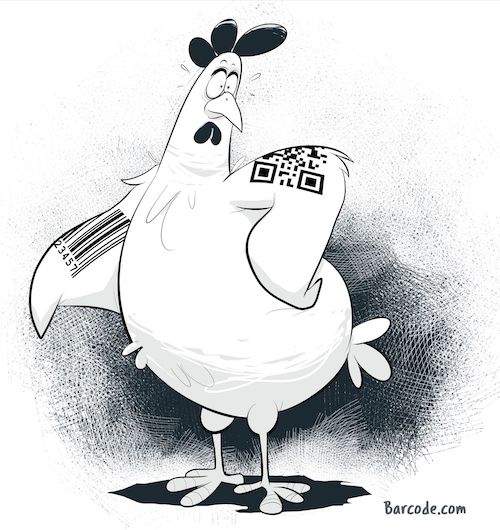
How honest barcodes overcharge customers. A true story.
I don’t often eat fried foods. And fried chicken is definitely a no-no on my list due to the fat and cholesterol. But recently I was on a long bike ride and needing a light snack at lunchtime to keep the exercise going. There was a Publix on the corner and the smell of fried chicken emanating from its vents was seductive and overpowering, like a Siren calling sailors to their death in Homer’s Odyssey. In a moment of weakness I walked inside and headed to the deli section.
I just needed a little taste, not a full meal, just a small hit, so to speak. It was $6.69 lb. (see picture of sign in inset - more about this later).
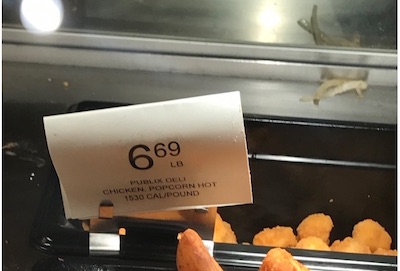

Now, Publix puts its popcorn chicken in a cup.
I told the lady behind the counter to just fill the cup about a third of the way. She filled it all the way. Uh, hello. I told her I only wanted a little and had her take a bunch out. She said they were going to charge me for the whole cup.
I did not understand how that was possible since it was being sold by weight - or at least that is what the sign implied.
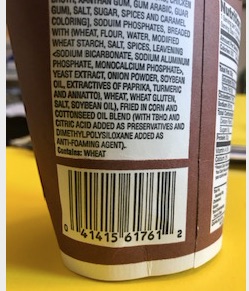

I told her that it was sold by weight. She did not look pleased. I guess I was making extra work for her. She put it on the scale and rung it up - but I had to tell her the price. She printed a ticket with a barcode and put it on the cup. Good, so far. 84 cents worth of chicken was what came up - 84 cents worth of guilty food pleasure - I could live with that. I thanked her and headed to the cashier. 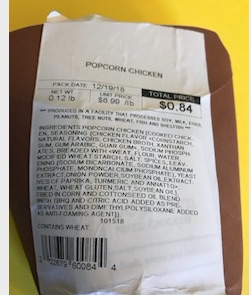

Well, as the cashier rang it up on the POS system, the price was $3.04. Whoa. What happened? She had scanned the wrong bar code. Where was the system failure?
Well, it turns out that the cup had a preprinted bar code on it for a full serving and that was what the cashier had scanned. Now I understood why the lady behind the deli counter made a face when putting it on the scale.
I pointed out the label that was printed at the deli, and she quickly corrected it - but there you have it. Two bar codes on a product - and both were within eyesight of the laser scanner. Technically, the deli counter person should have placed the printed label over the other bar code so it would not scan. That’s probably not realistic to expect from store personnel who are accustomed to processing hundreds of cups of popcorn chicken a week in only one manner. I screwed up the system. #myfault. Sigh. I have a sign on my wall an ex-girlfriend made for me. It says “Go with the Flow”. Clearly, I did not go with the flow - and I attribute no blame to Publix or their staff. I bring it up here as an example of the limitations of bar code technology. Despite its 99.9999% rate of accuracy, things can and do fail in a well designed system. 

Now, that wasn’t the only error- the price on the sign in the deli case was $6.69 per pound, and it rang up as $6.99 per pound, and overcharged me by a dime or so. While normally I would go to the customer service counter and show them the discrepancy, and get the item for free (Publix is great that way), today I was just hungry and didn’t want to be bothered*. (see receipt image on right) 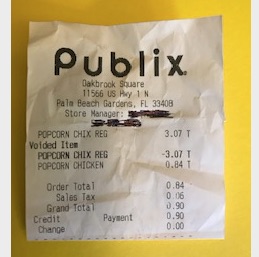

The moral of the story - bar codes are almost always perfect, but whenever they interact with humans the process becomes highly fallible.
* Last month I got a 12oz filet mignon for free when the price on the shelf was $11.49 and it rung up as $14.49 - Publix gives the item free to the customer if they find errors - so they bought me dinner that night. And, ditto for a package of broccoli in November that rang up as $3.99 instead of $2.99. (Why does it seem mis-marked prices are always higher???). I only buy maybe 50 different items at the average Publix over the course of a year, so if in a given year, five of those items are mis-priced at some point, then that’s a 10% error rate in labeling. It’s huge! In fact, if I could walk around the store with a price-check gun, I could probably get a bunch of free stuff from them. I love getting free stuff, but it’s distressing how many items are mislabeled - and Publix is not the only place I have seen this.
The point is that parts of the supply chain in retail food may be well automated, but execution is less so.

Article by Craig L Aberle, conspicuously biking around Florida in a bar code bike jersey.
Craig Aberle is the President of Bar Code Media Group, Inc., and the owner and publisher of The Bar Code News, https://www.barcode.com and former owner of The Point of Sale News (https://www.pointofsale.com ). He was the founder and CEO of MicroBiz Corp from 1985 to 2000, a leading developer of point-of-sale software. He has an undergraduate degree from SUNY @ Buffalo and an MBA from The Wharton School. He has served as a volunteer for SCORE mentoring small business owners, is an author of - "How To Computerize Your Small Business." (Wiley and Sons NY), and has given over 100 seminars on “The Benefits of Automation.” He enjoys cycling, skiing, yoga and an occasional triathlon.
More #MyBrokenSupplyChain articles
This article was modified slightly from its original version where two other companies were mentioned briefly. In hindsight I felt that I should address those issues more clearly in full detail in the future.
